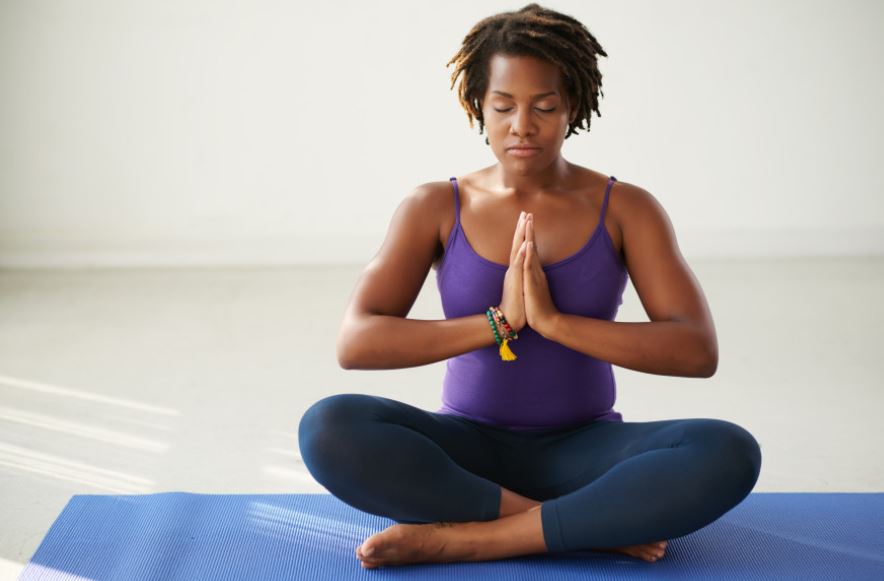
A regular meditation practice has been shown to reduce levels of stress and anxiety, improve sleep and concentration, promote kindness and self-awareness, lower blood pressure and reduce cognitive decline. But what exactly is meditation, and how do you do it? Yoga teacher Melanie Hancill explains…
It’s not about clearing the mind…
The two most common things that put people off meditation are the belief that you have to sit and clear the mind, and that you have failed at the practice if you get lost in thought. But it is really important to understand that we can’t completely empty the mind of thoughts – our brains are wired to think.
Mindfulness meditation is the practice of simply noticing those thoughts as they come along. We start with the intention of focusing on the breath, and when we notice that the mind has wandered off, we gently invite the awareness back to the breath. Over time, we become aware of the kind of thoughts that come up for us – without getting lost in them or judging them as ‘good’ or ‘bad’.
Practice makes perfect
If you’re new to meditation, it can feel strange to sit and observe the mind – it might be the first time you’ve ever done this. A simple way of thinking about meditation is that it is an exercise to train the mind, a bit like how fitness exercises train the body. The more we do, the easier it will become. Often, the mind begins to wander after only one breath, but that’s OK. In time, the moments of stillness and calm between the thoughts may become bigger, helping you to feel more calm, focused and less reactive.
ALSO READ: Alien yoga, the new fitness sensation
How long should I meditate for?
Set small goals, such as meditating for 2 minutes every morning. When that feels ok, up the time to 5, 10 or 20 minutes.
How to do it…
1. Start by finding a comfortable seat. Somewhere you can sit up tall – either cross-legged on the floor or in a chair. Close your eyes or soften your gaze so you are not focusing on anything in particular. Place your hands with the palms down on the tops of your thighs.
2. Take a moment to notice the sensation of sitting – become aware of the ground or chair beneath you, and the parts of your body in contact with them. Now bring your focus to your hands, noticing the weight of them on your thighs, and the sensation of the fabric of your clothes on your skin.
3. Now begin to notice how your breath feels in your body as you inhale and exhale. Make no effort to change the breath, simply let your natural breath flow in and out. Perhaps you feel your belly or your chest rising as you inhale and then falling as you exhale. Or you notice the cool sensation of the breath as it enters your nose and goes down your throat, and the sensation of the warmed breath leaving your body as you breathe out.
4. Aim to stay focused on these sensations of the breath, but when you notice the mind wandering, acknowledge the thought, then come back to the breath again.
5. When you are ready to end your practise, notice the sensations of the ground beneath you, and slowly open your eyes.
ALSO READ: How you can use a potato to help get rid of neck pain and migraines
Mindful moments throughout the day
You don’t always have to sit to meditate, you can use everyday tasks as tools to drop into the present moment. Try these…
Washing your hands
See if you can pay attention to the movement of your hands, the sensation of the soap and water trickling off them, and how the skin feels once you have dried your hands.
Eating
We’re often busy or chatting while we eat. Instead, notice how each mouthful of food feels – the taste, sensation and sound – as you chew.
Walking up stairs
Rather than seeing the action as a means to an end (either getting to the top or bottom of the stairs), notice the movement and positioning of your feet on each step.
 The Standard Group Plc is a multi-media organization with investments in media
platforms spanning newspaper print
operations, television, radio broadcasting, digital and online services. The
Standard Group is recognized as a
leading multi-media house in Kenya with a key influence in matters of national and
international interest.
The Standard Group Plc is a multi-media organization with investments in media
platforms spanning newspaper print
operations, television, radio broadcasting, digital and online services. The
Standard Group is recognized as a
leading multi-media house in Kenya with a key influence in matters of national and
international interest.



